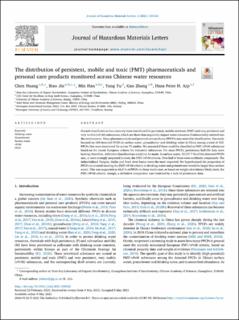| dc.description.abstract | Hazard classifications have recently been introduced for persistent, mobile and toxic (PMT) and very persistent and very mobile (vPvM) substances, which are those that negatively impact water resources if substantially emitted into the environment. Many pharmaceuticals and personal care products (PPCPs) may meet this classification. Our study focused on 169 detected PPCPs in surface water, groundwater and drinking water in China among a total of 432 PPCPs that were monitored for across 75 studies. We assessed if these could be classified as PMT/vPvM substances based on the recent European criteria for industrial substances. For most PPCPs, persistency half-life data were lacking; therefore, definitive classifications could not be made. In surface water, 52 (37.7 %) of the detected PPCPs met, or were strongly suspected to meet, the PMT/vPvM criteria. Over half of these were antibiotic compounds. The industrialized Yangtze, Haihe and Pearl river basins were the most impacted. We hypothesized the proportion of PPCPs monitored meeting the PMT/vPvM criteria in drinking water and groundwater would be larger than surface water. This was supported as 44.3 % of PPCPs in these media met, or based on weight-of-evidence likely meet, the PMT/vPvM criteria; though, a definitive comparison was hindered by a lack of persistence data. | |
